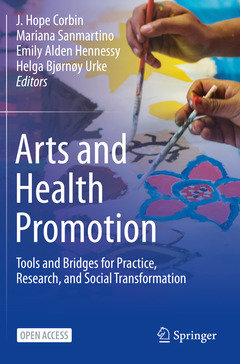Arts and Health Promotion, 1st ed. 2021 Tools and Bridges for Practice, Research, and Social Transformation
Coordonnateurs : Corbin J. Hope, Sanmartino Mariana, Hennessy Emily Alden, Urke Helga Bjørnøy

This open access book offers an overview of the beautiful, powerful, and dynamic array of opportunities to promote health through the arts from theoretical, methodological, pedagogical, and critical perspectives. This is the first-known text to connect the disparate inter-disciplinary literatures into a coherent volume for health promotion practitioners, researchers, and teachers. It provides a one-stop depository for using the arts as tools for health promotion in many settings and as bridges across communities, cultures, and sectors.
The diverse applications of the arts in health promotion transcend the multiple contexts within which health is created, i.e., individual, community, and societal levels, and has a number of potential health, aesthetic, and social outcomes. Topics covered within the chapters include:- Exploring the Potential of the Arts to Promote Health and Social Justice
- Drawing as a Salutogenic Therapy Aid for Grieving Adolescents in Botswana
- Community Theater for Health Promotion in Japan
- From Arts to Action: Project SHINE as a Case Study of Engaging Youth in Efforts to Develop Sustainable Water, Sanitation, and Hygiene Strategies in Rural Tanzania and India
- Movimiento Ventana: An Alternative Proposal to Mental Health in Nicaragua
- Using Art to Bridge Research and Policy: An Initiative of the United States National Academy of Medicine
Arts and Health Promotion is an innovative and engaging resource for a broad audience including practitioners, researchers, university instructors, and artists. It is an important text for undergraduate- and graduate-level courses, particularly in program planning, research methods (especially qualitative methodology), community health, and applied art classes. The book also is useful for professional development among current health promotion practitioners, community nurses, community psychologists, public health professionals, and social workers.
- Theoretical frame
- Case/project/study
- Details surrounding methods/technique
- Results/outcomes and implications
- Poetry (Proposed author: Sara Zarei, Iran)
- Music (Proposed author: Alexandra McEwan, Australia)
- Art Therapy (Proposed author: Arturo Solari, Mexico)
- Map-making (Proposed author: Oliver Mweemba, Zambia)
- Literature (Proposed author: Anunciata Sawada, Brazil)
- Muralism / Grafitti (Proposed partner in Iraq: https://en.ircs.org.iq/wp-content/uploads/2016/10/The-IRAQI-RED-CRESCENT-SOCIETY-BULLETIN-32.pdf)
- Arts-based methods in health research (Proposed authors: Kimberly Diane Fraser and Fatima al Sayah, Canada)
- Photovoice (Proposed author: Ozge Karadag Caman, Turkey)
- Art to communicate research findings: Applied theater (Proposed author: Steve Harvey, Latin America and US)
- Drawings in research (Proposed author Elizabeth Broadbent, New Zealand; Marilys Guillemin, Australia; Katarzyna Nowicka-Sauer, Poland)
- Audiovisual resources in health and social sciences (Proposed author: Serena Brigidi, Spain)
- Kaleidoscopic approach to Chagas' disease (confirmed author Mariana Sanmartino, Argentina)
- Artivism (Proposed authors: Carlos Cáceres, Alfonso Silva Santisteban and Fernando Olivos, Perú)
- Critical Photography (Proposed author: Jennifer Mokos, United States)
- Cinema as a resource for promoting health (Proposed partner in Spain: www.cineysalud.com)
- Thinking about health promotion from the sociology of the image (Proposed author: Silvia Rivera Cusicanqui, Bolivia)
- Using the art in higher education for professional preparation (confirmed author Hope Corbin, United States and Norway)
J. Hope Corbin is associate professor and director of the Human Services program in the department of Health and Community Studies at Western Washington University in Bellingham. Her scholarship focuses on intersectoral collaboration to reduce inequity in the social determinants of health and on partnership as a mechanism for leveraging diverse ways of knowing, and power, for emancipatory health promotion. She is particularly interested in North-South partnership and promoting equity in global health promotion research. She is also focused on how incorporating the arts in health promotion practice, research, and social mobilization can provide a promising pathway toward transformation, liberation and healing for individuals, settings, communities and societies. Hope serves as Vice President for the International Union for Health Promotion and Education's (IUHPE) North American Region, Faculty Mentor to the IUHPE's Student and Early Career Network, and as Deputy Editor-in Chief to Health Promotion International.
Mariana Sanmartino (PhD in Education Sciences) is a biologist and a specialist in Social Sciences and Health and in Epistemologies of the South. She works as a researcher for the National Board of Scientific and Technical Research (CONICET) in the Grupo de Didáctica de las Ciencias in La Plata, Argentina. She is the founder and coordinator of the group ¿De qué hablamos cuando hablamos de Chagas? (What do we speak about when we speak about Chagas?), whose main objective is to promote an understanding of Chagas disease from an integrated and innovative perspective, linking multiple voices, diverse artistic expressions and unconventional scenarios. The guiding thread of her career is the search for elements that make it possible to understand the problem of Chagas from an integral perspective highlighting the role of education and communication as key tools to address this complex and current issue. Mariana is Member of the Advisor
Synthesizes theory on health promotion and applied arts for a wide range of scholars, practitioners, and educators
Provides inspiring materials to spark innovative applications for practice
Presents numerous illustrated practical examples that bridge geographical locations, languages, cultures, and experiences
Applies a critical approach that promotes discussion of how the arts contribute to social justice
This book is open access, which means that you have free and unlimited access.
Date de parution : 01-2022
Ouvrage de 367 p.
15.5x23.5 cm
Date de parution : 03-2021
Ouvrage de 367 p.
15.5x23.5 cm
Thèmes d’Arts and Health Promotion :
Mots-clés :
health promotion; creative arts; health; and well-being; health communication; health education; interdisciplinary; qualitative research; social justice; cultural diversity; public health; community health; socio-environmental health; applied arts; indigenous health promotion; art therapy; health humanities; medical humanities; arts-related research; health disparities; health equity; open access



